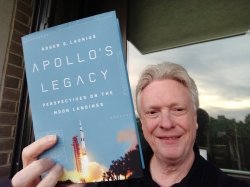
University Calendar
Apollo: 50 Years Later

Apollo: 50 Years Later
Dr. Roger Launius, former NASA Chief Historian and Associate Director at the Smithsonian Air & Space Museum
I recently published a book on the meaning of Apollo after fifty years. This presentation discusses what I found.
I shall explore four interrelated narratives of Apollo, one that is a master narrative and three minor variations. These include: (1) the dominant narrative of American triumph, exceptionalism, and success; (2) the counter narrative of criticism of Apollo from the left, wasting funds on a worthless expense that yielded little when so many Americans could have benefited from spending on social programs; (3) a criticism of the Moon landings from the right of the political spectrum focusing on the program as a representation of liberal taxing and spending strategies; and (4) a fringe narrative that denies the Apollo Moon landings in favor of a deep-seated conspiracy. Each of these narratives has a place in the American consciousness as it remembers Apollo after fifty years.
This begs several questions. What has been the significance of the Moon landings after some fifty years? How do those who recall the effort understand it in first decades of the twenty-first century, a postmodern world far removed from that of the late 1960s and early 1970s? What do the Moon landings mean to people of differing cultural, generational, economic, and ethnic backgrounds? What role did Apollo play at the time—and after—in helping to define modern American society, politics, and self-perception? What is it about the Apollo program that captured the imagination—that is, if it did—of the American people? Finally, what about Apollo retains its saliency some fifty years after the fact?
Speaker Biography
Dr. Roger D. Launius is Principal of Launius Historical Services. Between 2002 and 2017 he worked in several positions at the Smithsonian Institution’s National Air and Space Museum in Washington, D.C., most recently as Associate Director for Collections and Curatorial Affairs. Between 1990 and 2002 he served as chief historian of the National Aeronautics and Space Administration. During at 35-year career as a U.S. government historian, he has been involved in many issues relating to public history and the history of aerospace technology. He has written or edited more than thirty books on aerospace history, including Apollo's Legacy: The Space Race in Perspective (Smithsonian Books, 2019); Reaching for the Moon: A Short History of the Space Race (Yale, 2019); The Smithsonian History of Space Exploration: Discoveries from the Ancient World to the Extraterrestrial Future (Smithsonian Books, 2018), NASA Spaceflight: A History of Innovation (Palgrave Macmillan, 2018), and Historical Analogs for the Stimulation of Space Commerce (NASA, 2014). In addition, he is a Fellow of the American Association for the Advancement of Science, the International Academy of Astronautics, and the American Astronautical Society; and Associate Fellow of the American Institute for Aeronautics and Astronautics. He is frequently consulted by the electronic and print media for his views on space issues and has been a guest commentator on National Public Radio and all the major television news networks.